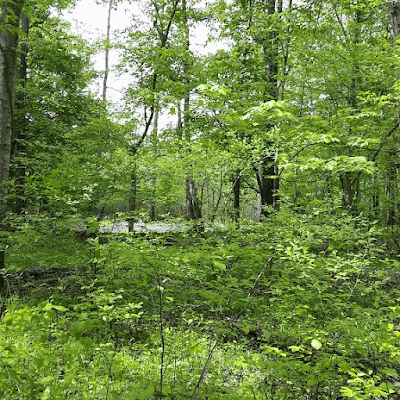Spring comes to southernmost Illinois a few weeks earlier than the northeastern corner where I live. Itching for some hiking and paddling, I planned a trip to the Shawnee Hills and Cache River basin. The landscape of southern Illinois is unique because it lies at the convergence of four physiographic provinces: coastal plains (south), Ozark plateau (west), low interior plateau (east), and the central lowlands (north).
The trip involved camping in the Crab Orchard National Wildlife Refuge. Most wildlife refuges do not permit camping, but there are 8 campsites on Crab Orchard's Devil's Kitchen Lake. The blossoming dogwoods laced the forest. It rained a lot the first night, but I love the sound and smell of rain when I am tucked in a dry tent and warm sleeping bag.
The bird sightings at Devil's Kitchen were fantastic. Among 40 species I observed in the campsite, the highlights were common loons, osprey, pileated woodpecker, summer tanager, eastern whip-poor-will, barred owl, and great horned owl.
The trip involved camping in the Crab Orchard National Wildlife Refuge. Most wildlife refuges do not permit camping, but there are 8 campsites on Crab Orchard's Devil's Kitchen Lake. The blossoming dogwoods laced the forest. It rained a lot the first night, but I love the sound and smell of rain when I am tucked in a dry tent and warm sleeping bag.
The bird sightings at Devil's Kitchen were fantastic. Among 40 species I observed in the campsite, the highlights were common loons, osprey, pileated woodpecker, summer tanager, eastern whip-poor-will, barred owl, and great horned owl.
A morning hike at Ferne Clyffe State Park yielded otherworldly rock formations covered with ferns. Again, the birding was excellent, including black vulture, wild turkey, Louisiana waterthrush, and several other warblers. Best bird species was a pair of worm-eating warblers. The wildflowers were also spectacular, including mayapple, squirrel corn, dwarf larkspur, and jack-in-the-pulpits. There was even a morel mushroom on the trail.
One of my favorite places in the Cache River basin is Heron Pond Nature Preserve, a national natural landmark. A short walk along the river leads to a secluded cypress paradise. Best bird was the white-eyed vireo, which I initially misidentified by ear as gray catbird. It was competing for attention with a flurry of prothonotary warblers. The visit to Heron Pond was part of an outing with the Illinois chapter of the Nature Conservancy. Two venerable retired IDNR staff reminisced with our group about acquiring this special place to protect it.
The activities concluded with a canoe trip through the Buttonland Swamp of the lower Cache River, which has been the home of Illinois' champion bald cypress tree for over 1,000 years. The Cache River watershed contains 91% of Illinois' high-quality swamp/wetland habitat and is recognized as a wetland of international importance. One key conservation goal is reconnecting two parts of the Cache artificially separated by the Post Creek Cut Off, a ditch completed in 1916. The Nature Conservancy is hoping to facilitate the reconnection through the Grassy Sough Preserve with federal and state partnerships. Without the natural flow from the upper Cache, the lower Cache accumulates silt that threatens the long-term health of trees and aquatic animals.




1 comment:
Nice summary of the trip and great pictures.
Post a Comment